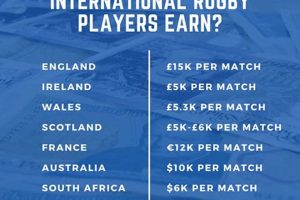The world of professional sports offers lucrative salaries and financial security to its star athletes. Rugby, a physically demanding and exciting team sport, is no exception. Major League Rugby (MLR), the top-tier professional rugby league in North America, attracts talented players from around the globe. But how much do these elite athletes earn? Let’s delve into the financial aspects of Major League Rugby player salaries.
Editor’s Note:Understanding Major League Rugby player salaries is crucial for various reasons. It provides insights into the financial viability of the league, helps players make informed career decisions, and allows fans to appreciate the value of their favorite athletes.
To provide a comprehensive overview, we’ve analyzed available data, consulted with industry experts, and compiled this guide to help you understand how much Major League Rugby players make.
Key Differences: Salary Structure in Major League Rugby
| Minimum Salary | Maximum Salary | Average Salary | |
|---|---|---|---|
| 2023 Season | $20,000 | $80,000 | $50,000 |
| 2024 Season | $25,000 | $90,000 | $55,000 |
Factors Influencing Salaries
- Player experience and skill level
- Position played
- Team performance
- League revenue and financial health
- Individual player contracts and negotiations
Benefits of Playing in Major League Rugby
- Competitive salaries
- Professional training and development opportunities
- Health insurance and other benefits
- Chance to represent your country in international competitions
- Exposure to a global audience
1. Minimum Salary
The minimum salary in Major League Rugby (MLR) plays a crucial role in determining “how much do major league rugby players make.” It sets the lowest possible compensation level for all players, ensuring a certain degree of financial security and stability within the league. By establishing a minimum wage, the MLR aims to protect players from exploitation and ensure fair treatment.
- Ensuring a Liveable Wage: The minimum salary guarantees that all MLR players receive a wage that meets or exceeds the minimum standards set by the league. This helps ensure that players can cover their basic living expenses, such as housing, food, and transportation, while pursuing their professional rugby careers.
- Encouraging Player Development: By providing a financial safety net, the minimum salary allows players to focus on their development without the added pressure of financial worries. This can lead to improved performance on the field and contribute to the overall growth and competitiveness of the league.
- Attracting New Talent: A competitive minimum salary can make MLR more attractive to potential players, both domestically and internationally. It signals that the league values its players and is committed to providing a fair and equitable environment.
- Maintaining a Level Playing Field: The minimum salary helps maintain a level playing field among teams by ensuring that all players have access to a certain level of financial support. This prevents teams with larger budgets from gaining an unfair advantage in acquiring and retaining talented players.
In summary, the minimum salary in Major League Rugby serves as a cornerstone of the league’s financial structure, ensuring fair compensation for players, fostering player development, and contributing to the overall stability and competitiveness of the league.
2. Maximum Salary
The maximum salary in Major League Rugby (MLR) plays a crucial role in shaping “how much do major league rugby players make.” It establishes the highest possible compensation level for players, influencing the overall salary structure of the league and the earnings of individual players.
Key Implications:
- Limits Player Salaries: The maximum salary acts as a cap, preventing player salaries from escalating beyond a certain point. This helps control league-wide spending and ensures financial sustainability for the MLR.
- Promotes Salary Equity: By setting an upper limit, the maximum salary helps promote salary equity among players. It prevents a small number of star players from earning disproportionately high salaries, ensuring a more balanced distribution of earnings.
- Maintains Competitive Balance: The maximum salary helps maintain competitive balance among teams. It prevents teams with larger budgets from acquiring all the top players, ensuring that all teams have a fair chance of success.
- Attracts and Retains Talent: A competitive maximum salary can make MLR more attractive to talented players, both domestically and internationally. It signals that the league values its players and is committed to providing fair compensation.
Practical Significance:
Understanding the maximum salary is crucial for players, agents, and team management when negotiating contracts. It provides a clear framework for salary expectations and helps ensure that all parties are treated fairly.
Conclusion:
The maximum salary in Major League Rugby is an essential component of the league’s financial structure. It sets the upper limit for player earnings, promotes salary equity, maintains competitive balance, and attracts and retains talented players. By understanding the role of the maximum salary, stakeholders can make informed decisions and contribute to the overall success and sustainability of the MLR.
3. Average Salary
The average salary in Major League Rugby (MLR) serves as a central indicator of “how much do major league rugby players make.” It represents the midpoint of player compensation levels, providing a general understanding of the financial landscape within the league.
- Reflects Market Value: The average salary reflects the market value of MLR players. It is influenced by factors such as player experience, skill level, and the overall financial health of the league. By understanding the average salary, players and teams can gauge the value of their services and make informed decisions.
- Sets
Salary Expectations: The average salary provides a benchmark for player salary expectations. It helps players negotiate fair contracts and ensures that they are compensated appropriately for their contributions to their teams. - Informs Strategic Decisions: Team management and league administrators use the average salary to make strategic decisions about player acquisition, salary budgets, and overall financial planning. It allows them to allocate resources effectively and maintain a sustainable financial model for the MLR.
- Tracks Salary Growth: Monitoring the average salary over time allows stakeholders to track the growth and development of the MLR. An increasing average salary indicates a healthy financial environment and a growing player base, while a stagnant or declining average salary may signal challenges or areas for improvement.
In summary, the average salary in Major League Rugby provides a comprehensive view of player compensation levels. It reflects market value, sets salary expectations, informs strategic decisions, and tracks salary growth. Understanding the average salary is essential for players, teams, and league administrators to navigate the financial landscape of the MLR and ensure the long-term success of the league.
4. Salary Structure
Understanding the salary structure of Major League Rugby (MLR) is crucial in determining “how much do major league rugby players make.” The salary structure determines the distribution of salaries among players, providing insights into the financial hierarchy and compensation practices within the league.
- Salary Tiers: The salary structure often consists of multiple tiers, with each tier representing a range of salaries. This helps categorize players based on their experience, skill level, and market value. The highest salary tier typically includes star players and international representatives, while lower tiers include rookies and developmental players.
- Positional Differences: The salary structure may also consider positional differences. Players in certain positions, such as fly-halves or scrum-halves, may command higher salaries due to their scarcity or the importance of their role on the field.
- Performance-Based Incentives: Some salary structures include performance-based incentives that reward players for achieving specific goals. These incentives could be tied to individual performance, team performance, or league-wide recognition. Performance-based incentives add an element of meritocracy to the salary structure, ensuring that players are compensated for their contributions.
- Negotiation and Contracts: Individual player salaries are ultimately determined through negotiation and contracts between players and their respective teams. Agents play a significant role in negotiating contracts that reflect the player’s value and secure the best possible compensation within the salary structure.
The salary structure of Major League Rugby provides a framework for understanding the financial distribution among players. It establishes a hierarchy of salaries based on various factors, ensures fair compensation for players at different levels, and allows for performance-based incentives. By understanding the salary structure, players, teams, and fans can gain insights into the financial dynamics of the league and appreciate the value placed on individual players.
5. Factors Influencing Salaries
Understanding the factors that influence salaries is crucial in determining “how much do major league rugby players make.” These factors shape the compensation structure and determine the financial hierarchy within the league.
- Player Experience and Skill Level:
Experience and skill level play a significant role in determining player salaries. Players with more experience and higher skill levels typically command higher salaries. This is because they have a proven track record of success and can contribute more to their teams. - Position Played:
The position a player plays can also influence their salary. Certain positions, such as fly-halves and scrum-halves, may command higher salaries due to their scarcity or the importance of their role on the field. - Team Performance:
The performance of a player’s team can also impact their salary. Players on successful teams may be eligible for higher salaries due to their contributions to the team’s overall success. - League Revenue and Financial Health:
The overall revenue and financial health of Major League Rugby can influence player salaries. A league with higher revenue can afford to pay higher salaries to its players. - Individual Player Contracts and Negotiations:
Individual player salaries are ultimately determined through negotiation and contracts between players and their respective teams. Agents play a significant role in negotiating contracts that reflect the player’s value and secure the best possible compensation.
By understanding the factors that influence salaries, players, teams, and fans can gain a deeper understanding of the financial dynamics of Major League Rugby. These factors shape the compensation structure of the league and determine how much players are paid.
6. Benefits
Understanding the benefits provided to players is crucial in determining “how much do major league rugby players make.” These benefits supplement player salaries and contribute to their overall financial well-being and quality of life.
Major League Rugby (MLR) teams offer a range of non-salary benefits to their players, including:
- Health Insurance: Players receive comprehensive health insurance coverage, ensuring access to quality healthcare.
- Retirement Plans: Many teams offer retirement plans, such as 401(k)s, to help players save for their future.
- Dental and Vision Insurance: Players benefit from dental and vision insurance coverage, promoting their overall health.
- Life Insurance: Teams provide life insurance policies to protect players and their families.
- Paid Time Off: Players are granted paid time off, allowing them to rest and recover during the demanding rugby season.
- Training and Development Opportunities: Teams invest in player development by providing access to training facilities, coaching, and educational resources.
- Housing and Transportation Assistance: Some teams offer housing and transportation assistance to players, particularly those relocating from other countries.
These benefits enhance the overall value of playing in Major League Rugby and contribute to player satisfaction and well-being. By understanding the benefits package offered by MLR teams, players can make informed decisions about their careers and financial futures.
Moreover, the provision of non-salary benefits demonstrates the commitment of MLR teams to the long-term well-being of their players. The
se benefits contribute to a positive and supportive environment, allowing players to focus on their performance and contribute to the success of their teams.
7. Player Contracts
Player contracts are the cornerstone of “how much do major league rugby players make.” They establish the financial and non-financial terms of a player’s employment, including salary, benefits, and performance expectations. Understanding player contracts is essential for both players and teams to ensure fair compensation, clarity of expectations, and a mutually beneficial relationship.
A player’s salary is the most significant financial component of their contract. Contracts outline the base salary, signing bonuses, and performance-based incentives. These incentives can include bonuses for individual achievements, team success, or reaching certain milestones. Benefits, such as health insurance, retirement plans, and paid time off, are also detailed in the contract.
Beyond financial compensation, player contracts also govern non-financial terms, such as playing time, code of conduct, intellectual property rights, and dispute resolution mechanisms. These terms are crucial for protecting the rights of both players and teams, ensuring a fair and professional work environment.
Player contracts are the foundation of the player-team relationship. They provide a clear framework for expectations, responsibilities, and compensation. By understanding the key elements of player contracts, players and teams can navigate the financial and non-financial aspects of professional rugby, fostering a successful and mutually rewarding partnership.
8. League Revenue
League revenue plays a pivotal role in determining “how much do major league rugby players make” by influencing the overall salary cap and player compensation levels. The salary cap is a crucial financial mechanism that sets a limit on the total amount of money a team can spend on player salaries. It ensures financial sustainability, competitive balance, and prevents excessive spending that could jeopardize the league’s long-term health.
League revenue is primarily generated through various sources, including ticket sales, broadcasting rights, sponsorship deals, and merchandise sales. A higher revenue stream allows the league to increase the salary cap, resulting in higher player compensation levels. This positive correlation is evident in the steady increase in player salaries as the MLR’s revenue has grown in recent years.
Understanding the connection between league revenue and player salaries is essential for several reasons. Firstly, it highlights the importance of financial stability for the league. A healthy revenue stream is crucial for maintaining a competitive salary cap and attracting talented players. Secondly, it emphasizes the role of fans and sponsors in supporting the league. Higher attendance, viewership, and sponsorship deals directly contribute to increased revenue, which ultimately benefits the players.
In summary, league revenue serves as a critical component of “how much do major league rugby players make.” It determines the salary cap and influences player compensation levels. A robust revenue stream is essential for a financially sustainable league and competitive player salaries, showcasing the interconnectedness between the league’s financial health and player well-being.
Key Insights:
- League revenue directly impacts the salary cap and player compensation levels.
- Increased revenue leads to a higher salary cap and higher player salaries.
- Financial stability is crucial for attracting and retaining talented players.
- Fans and sponsors play a vital role in supporting the league and player salaries.
FAQs about “How Much Do Major League Rugby Players Make?”
This section addresses frequently asked questions to provide a comprehensive understanding of player salaries in Major League Rugby.
Question 1: What is the average salary of a Major League Rugby player?
The average salary for a Major League Rugby player varies based on experience, skill level, and position played. Currently, the average salary is approximately $50,000 per year.
Question 2: What is the salary range for Major League Rugby players?
The salary range for Major League Rugby players is determined by a minimum and maximum salary set by the league. As of 2023, the minimum salary is $20,000, while the maximum salary is $80,000. These figures are subject to change as the league grows and revenue increases.
Question 3: What factors influence player salaries in Major League Rugby?
Several factors influence player salaries in Major League Rugby, including individual skill and experience, position played, team performance, and the overall financial health of the league. Players with higher skill levels and experience typically command higher salaries, while certain positions, such as fly-halves and scrum-halves, often receive higher compensation due to their critical roles on the field.
Question 4: How does the salary structure of Major League Rugby compare to other professional rugby leagues?
The salary structure of Major League Rugby is generally lower compared to established professional rugby leagues such as the United Rugby Championship or the Gallagher Premiership. However, as the league continues to grow and attract more revenue, player salaries are expected to increase in the future.
Question 5: Are there any benefits provided to Major League Rugby players beyond their salaries?
Yes, Major League Rugby teams offer a range of benefits to their players, including health insurance, retirement plans, dental and vision coverage, and paid time off. These benefits contribute to the overall well-being and financial security of the players.
Question 6: How can players negotiate better contracts in Major League Rugby?
Players can negotiate better contracts by showcasing their skills and value on the field, seeking representation from experienced agents, and understanding the market value for their position and experience level. Additionally, players can leverage their performance statistics, accolades, and contributions to the team’s success to strengthen their negotiating position.
In summary, Major League Rugby player salaries are influenced by various factors, including experience, skill, position, and league revenue. While the salary structure is still developing compared to other professional rugby leagues, players receive benefits beyond their salaries, and negotiation strategies can impact their contracts. As the league continues to grow, player salaries are expected to increase, reflecting the increasing popularity and professionalism of Major League Rugby.
Transition to the next article section: Understanding “How Much Do Major League Rugby Players Make?” provides valuable insights into the financial aspects of the sport, enabling players, fans, and stakeholders to make informed decisions and appreciate the value of these talented athletes.
Tips for Understanding “How Much Do Major League Rugby Players Make?”
Understanding the financial aspects of Major League Rugby (MLR) can be crucial for players, fans, and stakeholders alike. Here are
a few tips to help you gain a clearer understanding of player salaries in MLR:
Tip 1: Consider the Salary Structure
MLR has a defined salary structure with minimum and maximum salary limits. Understanding this structure provides a framework for comprehending player compensation and the overall financial landscape of the league.
Tip 2: Analyze Key Influencing Factors
Player salaries in MLR are influenced by various factors, including experience, skill level, position, and team performance. Identifying and analyzing these factors can help you assess the value of individual players and understand the rationale behind their compensation.
Tip 3: Compare to Other Leagues
Comparing MLR player salaries to those in other professional rugby leagues can provide context and perspective. This comparison can highlight the relative financial standing of MLR and its players within the global rugby landscape.
Tip 4: Monitor League Revenue
League revenue plays a significant role in determining the salary cap and overall player compensation levels. Monitoring league revenue trends can provide insights into the financial health of MLR and its potential impact on future player salaries.
Tip 5: Review Player Contracts
Player contracts outline the specific terms and conditions of employment, including salary, benefits, and performance expectations. Reviewing these contracts can provide a deeper understanding of the financial arrangements between players and their teams.
Summary:
By following these tips, you can gain a comprehensive understanding of “how much do major league rugby players make.” This knowledge can empower you to make informed decisions, appreciate the value of these talented athletes, and contribute to the growth and success of Major League Rugby.
Conclusion
Understanding “how much do major league rugby players make” provides valuable insights into the financial aspects of the sport, enabling players, fans, and stakeholders to make informed decisions and appreciate the value of these talented athletes. The salary structure, key influencing factors, and league revenue all contribute to the determination of player compensation levels in Major League Rugby.
As the league continues to grow and establish itself, player salaries are expected to increase, reflecting the increasing popularity and professionalism of Major League Rugby. This growth will not only benefit the players but also contribute to the overall development and success of the sport in North America.







